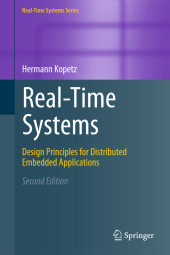 Neuerscheinungen 2013Stand: 2020-01-07 |
Schnellsuche
ISBN/Stichwort/Autor
|
Herderstraße 10
10625 Berlin
Tel.: 030 315 714 16
Fax 030 315 714 14
info@buchspektrum.de |

Hermann Kopetz
Real-Time Systems
Design Principles for Distributed Embedded Applications
2. Aufl. 2013. xviii, 378 S. XVIII, 378 p. 235 mm
Verlag/Jahr: SPRINGER, BERLIN 2013
ISBN: 1-461-42866-1 (1461428661)
Neue ISBN: 978-1-461-42866-4 (9781461428664)
Preis und Lieferzeit: Bitte klicken
This textbook is written for a high-level undergraduate or graduate course on real-time embedded systems or cyber-physical systems. Its practical approach to solving real-time problems also makes it an excellent choice for researchers and practitioners.
"This book is a comprehensive text for the design of safety critical, hard real-time embedded systems. It offers a splendid example for the balanced, integrated treatment of systems and software engineering, helping readers tackle the hardest problems of advanced real-time system design, such as determinism, compositionality, timing and fault management. This book is an essential reading for advanced undergraduates and graduate students in a wide range of disciplines impacted by embedded computing and software. Its conceptual clarity, the style of explanations and the examples make the abstract concepts accessible for a wide audience."
Janos Sztipanovits, Director
E. Bronson Ingram Distinguished Professor of Engineering
Institute for Software Integrated Systems
Vanderbilt University
Real-Time Systems focuses on hard real-time systems, which are computing systems that must meet their temporal specification in all anticipated load and fault scenarios. The book stresses the system aspects of distributed real-time applications, treating the issues of real-time, distribution and fault-tolerance from an integral point of view. A unique cross-fertilization of ideas and concepts between the academic and industrial worlds has led to the inclusion of many insightful examples from industry to explain the fundamental scientific concepts in a real-world setting. Compared to the first edition, new developments in complexity management, energy and power management, dependability, security, and the internet of things, are addressed.
The book is written as a standard textbook for a high-level undergraduate or graduate course on real-time embedded systems or cyber-physical systems. Its practical approach to solving real-time problems, along with numerous summary exercises, makes it an excellent choice for researchers and practitioners alike.
The Real-Time Environment.- Simplicity.- Global Time.- Real-Time (RT) Model.- Temporal Relations.- Power and Energy Awareness.- Dependability.- Real-Time Communication.- Real-Time Operating Systems.- Real-Time Scheduling.- System Design.- Validation.- Internet of Things.- The Time-Triggered Architecture.
From the reviews of the second edition:
"The book includes new chapters on simplicity, energy awareness, and the Internet, and, more importantly, some of the original chapters have been substantially revised. The book was designed to be a textbook. Its audience includes graduate and senior-level undergraduate students in real-time systems courses, as well as practitioners. ... Overall, this is a very good book." (Janusz Zalewski, ACM Computing Reviews, January, 2012)


